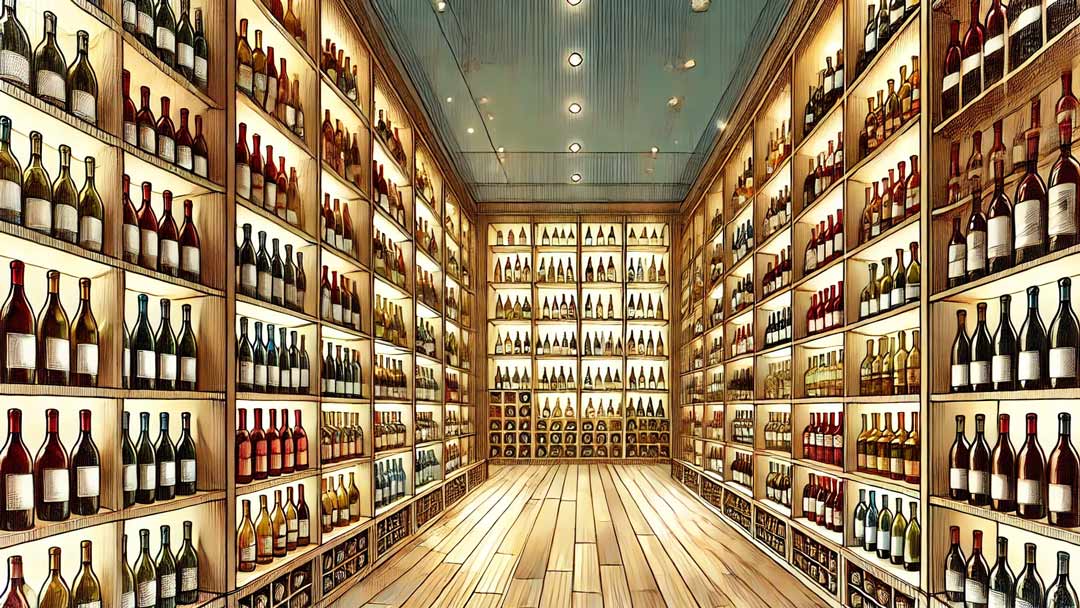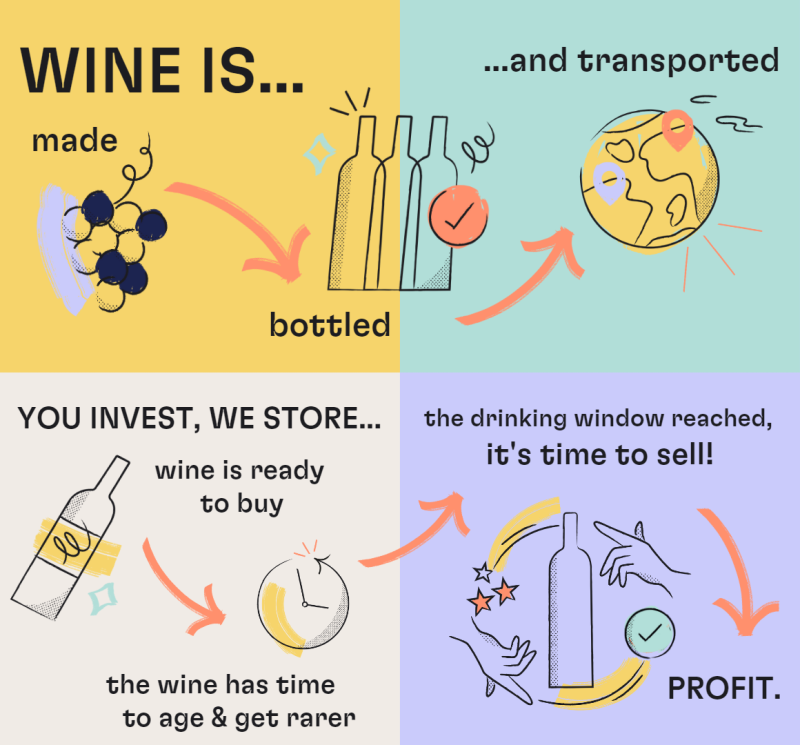
Wine Collector's Guide to Investing
Wine collecting has transformed from a hobby into a legitimate investment, attracting connoisseurs and savvy investors worldwide. As a tangible asset, Fine Wine, offers a blend of cultural significance, historical value, and ageing potential, making it an appealing addition to a diversified portfolio. Over the past two decades, wine investment has gained momentum thanks to the stability and growth seen in Fine Wine Markets.
Part 1: The Basics of Wine Investment
Part 2: Market Resilience Over Time
Part 3: How to Start Investing in Wine
Part 4: Managing and Growing Your Wine Investment
This guide explores the ins and outs of Fine Wine investing, helping you as a wine collector turn your passion into a profitable venture.
Part 1: The Basics of Wine Investment
What Makes Wine a Good Investment?
Fine Wine’s value is driven by its unique ageing potential, scarcity, and provenance. As fine wine ages, it enhances in complexity, flavour, and quality, making it more desirable over time.
The key factor is that while the wine improves, the supply diminishes—since bottles are consumed, the remaining stock becomes increasingly rare.
This creates a classic supply-and-demand dynamic: the scarcer the wine, the higher its value.
Moreover, high-demand wines are often produced in limited quantities, particularly those from prestigious regions or vintages. For example, top Bordeaux and Burgundy estates produce small quantities of each vintage, and once a vintage is sold out, there is no way to produce more.
This scarcity drives demand in secondary markets, where wine collectors and investors seek these rare bottles, willing to pay premiums as the available supply dwindles.
As a result, wine’s market value can appreciate substantially over time.
Provenance also plays a pivotal role. Knowing that a bottle has been carefully stored and comes from a reputable producer can significantly affect its value. Wines with impeccable provenance—often verified through detailed records of ownership and storage—are considered more reliable investments, as their quality and authenticity are guaranteed.
In addition to supply and demand fundamentals, wine offers liquidity. Unlike art or real estate, fine wine can be sold at auctions or through brokers relatively easily, giving investors a more flexible exit strategy.
Platforms such as the Liv-ex Fine Wine 100 Index track the performance of the most sought-after wines, providing transparency and showing that fine wine has consistently outperformed traditional investments like equities over the past two decades.
Types of Wine to Invest In
Investment-grade wines typically come from historically renowned regions such as Bordeaux, Burgundy, and Champagne, known for producing wines that appreciate in value. However, emerging regions like Tuscany (Italy) and Napa Valley (USA) are gaining traction among investors, as their top wines have shown significant price growth in recent years.
When selecting wines, consider region, vintage, and producer. Vintages from excellent harvest years and wines from celebrated producers like Château Lafite and Château Margaux in Bordeaux are often the most lucrative. Top producers like Domaine de la Romanée-Conti, Domaine Leroy, and Armand Rousseau are highly sought after in Burgundy. In Champagne, Krug and Dom Pérignon are consistently reliable investments. Sassicaia from Tuscany and Screaming Eagle from Napa Valley are also top performers in their respective regions.
Investing in wines from well-documented vintages and esteemed producers ensures greater predictability in value appreciation.
How Wine Markets Function
The fine wine market operates through multiple channels, including auctions, private sales, wine merchants, and online platforms. Wine auctions, such as those held by Sotheby’s and Christie’s, provide access to rare bottles, while private sales and wine merchants offer more exclusivity and personalised recommendations. Online investment platforms like Cult Wine Investment and CultX are designed to assist investors with tools for financial gain, focusing more on investment performance than on wine enthusiast or collector experiences.
The En Primeur market also plays a vital role, particularly in Bordeaux. It allows investors to purchase wines before bottling, often at lower prices, with the potential for significantly higher price appreciation than if purchased at general release. Buying En Primeur also ensures superior provenance, as wines are directly linked to the producer and stored under ideal conditions, enhancing their long-term value.

Part 2: Market Resilience Over Time
Historical Performance of Wine as an Asset
Wine has consistently demonstrated resilience during periods of financial instability. During the 2008 recession, for example, the Liv-ex Fine Wine 100 Index declined by only 10%, while global equity markets fell by over 40%. By 2011, the index had fully recovered and reached new heights, underscoring wine’s potential as a hedge against market volatility.
Over the long term, wine has outperformed traditional asset classes, offering investors both security and potential returns.
Why Wine Prices Are Stable
Several factors contribute to the stability of fine wine prices. The limited supply of high-quality wine, coupled with increasing global demand, creates favourable market conditions.
Emerging markets, such as China, have become major players in the fine wine sector, driving demand for premium vintages.
The cultural significance of wine and its role in luxury consumption further solidify its place as a stable, appreciating asset.
Long-Term Trends in Wine Investment
Historically, investment-grade wines from top regions have shown a steady upward trajectory in value. As wines age and approach their peak drinking windows, they typically reach their highest value. This long-term ageing process means that wine investments often require patience, but with proper storage and timing, the returns can be significant.
Part 3: How to Start Investing in Wine
Setting Your Investment Goals
Start by defining your investment objectives. Are you looking for short-term gains by trading highly sought-after wines, or do you prefer a long-term strategy that leverages the ageing process? Understanding your risk tolerance and investment horizon is critical in crafting a tailored approach to wine investment.
Building a Wine Portfolio
A diversified wine portfolio minimises risk and increases the potential for gains. Investors should consider diversifying by region, vintage, and producer.
For example, pairing high-risk wines from emerging regions with more established wines from Bordeaux or Burgundy can provide a balanced investment strategy. Look for wines from top-rated producers and regions with strong global demand.
Buying Wine: Where and How
When purchasing wine for investment, sourcing from reputable sellers is essential. Auctions offer access to rare bottles, while direct purchases from wineries ensure provenance. Wine investment platforms like Cult Wines Investment and CultX provide a modern, transparent route to building a portfolio.
Cult Wine Investment builds bespoke, diversified portfolios tailored to match investor goals, with a higher minimum investment level. In contrast, CultX offers a hands-on, self-serve approach with no minimum investment, allowing users to trade fine wines globally with tools like AI-powered analytics and live market data.
Always verify the wine’s authenticity, provenance, and condition to avoid counterfeit or compromised bottles.
Storage Considerations
Proper storage is crucial to preserving the value of your wine investment. Ideal storage conditions should maintain a temperature range of 55-59°F (13-15°C), humidity between 70-80%, and minimal exposure to light or vibration.
Many investors opt for bonded warehouses, which provide professional, temperature-controlled storage and additional benefits. When wine is stored "in bond," it remains untaxed and duty-free, allowing investors to sell or transfer the wine without paying taxes on its increased value.
Taxes and duties are only paid if you choose to take physical delivery, based on the original purchase price, not the current value.
Bonded warehouses also offer the flexibility to transfer wine to another bonded location, helping investors manage their portfolios more efficiently.
Part 4: Managing and Growing Your Wine Investment
Monitoring Market Trends
Regularly track market trends, vintage reports, and producer news to ensure you're making informed decisions.
Tools like Liv-ex, Wine-Searcher, and CultX offer valuable insights into price movements and the demand for specific wines.
Staying informed helps investors capitalise on buying opportunities and optimise the timing of their sales.
When to Sell
Selling wine at the right time is key to maximizing profits. Pay attention to market conditions, wine maturity, and your personal investment goals.
Wines that have reached their peak drinking window —when they are at their best for consumption—are often at their most valuable. If you plan to have your wines delivered, ensure it is timed for optimal enjoyment.
Auctions provide a platform to reach a broad audience, while private sales may yield more favourable terms. Evaluate both options to determine which is best for your fine wine collection.
Risks and Challenges
Despite its stability, wine investment does come with risks. Market fluctuations, counterfeit wines, and improper storage can diminish the value of your wine collection. Mitigating these risks requires careful due diligence, from sourcing wines through trusted sellers to ensuring optimal storage conditions.
Diversification and market monitoring can also help safeguard against potential losses.
Authentication Methods
Counterfeit wine is a significant risk in wine investing, making provenance and authenticity crucial. When buying wine in bond (before duty and tax are paid), it's essential to trace its history back to the producer. Traditional methods include visual inspections, provenance documentation, and expert authentication services, where records of the wine’s ownership and storage are carefully reviewed.
Technology is beginning to enter the fine wine market to enhance provenance verification and help avoid counterfeits. While still emerging, innovations like blockchain tracking, NFC tags, and QR codes are being explored to improve transparency and security for investors.
Ensuring proper provenance and authenticity helps maintain the value and credibility of wine investments, minimizing the risks associated with counterfeits.
Wine investing offers a unique blend of financial reward and personal enjoyment. With proper knowledge and strategy, wine collectors can build a portfolio that appreciates in value over time. By understanding market dynamics, diversifying your portfolio, and staying informed on trends, you can turn your passion for fine wine into a profitable investment.
As the global demand for rare and vintage wines continues to grow, the future of wine investment looks promising.






